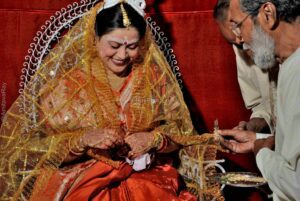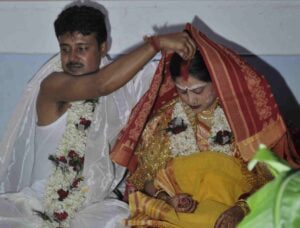Bengali Hindu wedding follows Bengali wedding traditions. The wedding venue includes Bengali wedding dresses and wedding rings as per bridal tradition. Marriage ceremonies in Indian wedding traditions involve wedding symbols in the tradition of marriage. A wedding is a ceremony where two people are legally wed. Wedding traditions and customs vary greatly between communities, ethnic groups, religions, countries, and social strata.
Traditional Indian Weddings
Most wedding ceremonies involve a couple exchanging marriage vows, a blessing being displayed (offering, rings, token items, flowers, money, dress), and a celebrant or authority figure publicly declaring the union. The function is occasionally followed by a wedding party, and extraordinary bridal attire are frequently worn. An Indian wedding typically includes music, lyrics, supplications, readings from holy books, as well as unusual customs that date back to ancient times.
Bengali Hindu Wedding
The Bengali wedding, i.e., the Bengali Hindu wedding, relates to Bengali wedding traditions with regional Indian subcontinental Hindu rituals and symbols. A Bengali Hindu wedding, also known as Biye (বিয়ে), is a stunning sight to behold. This kind of wedding features profound, important traditions steeped in culture and custom that are carried out amid a flurry of stunningly gorgeous and extraordinarily creative beauty.
Bengali Wedding Traditions
- A Bengali Hindu Marriage can be separated into the accompanying parts:
- Pre Wedding Rituals: AdanPradan (আদান-প্রদান), PatriPatra (পাটিপত্র), Ashirvad (আশীর্বাদ), AaiBudoBhaat (আইবুড়োভাত), Bid’dhi (বিদ্ধি), DodhiMangal (দধিমঙ্গল), HoludKota (হলুদকোটা), Adhibas (অধিবাস), Tatva (তত্ত্ব), KubiPatta (কুবিপত্র), Snan (স্নান), Sankha-Porano (শঙ্খ-পরানো).
- Marriage Ceremonies: BorBoron (বরবরণ), PottoBastra (পট্টবস্ত্র), SaatPaak (সাতপাক), MalaBadal (মালাবদল), SubhoDrishti (শুভদৃষ্টি), Sampradan (সম্প্রদান), Yagna (যজ্ঞ), SaptaPadi (সপ্তপদী) (with couple), Anjali (অঞ্জলি), SindoorDaan ceremony & Ghomta (সিঁদুরদান ও ঘোমটা).
- Post Wedding Traditions: BasharGhar (বাসরঘর), BashiBiye (বাসীবিয়ে), Bidaye (বিদায়), BouBoron (বধূবরণ), KaalRatri (কালরাত্রি), BouBhaat (বৌভাত), PhoolSajja (ফুলশয্যা), DiraGaman (দ্বিরাগমন).
Pre Wedding Rituals
Bengali weddings are celebrations of color, kinship, and greatness regardless of anything else. Bengalis preserve their roots firmly in traditional rituals and swear off appearance. Families plan elaborate activities that last two to three days and take place from early dawn to late at night. Among Bengal’s two main subcultures, the practices and how they are carried out are subtly unique.
The (1) Banggal (বাঙাল) are Bengali Hindus with roots in what is now Bangladesh, and the (2) Ghoti (ঘটি) are Bengali Hindus with roots in West Bengal. Let me tell you the step-by-step details of Bengali weddings, including Bengali wedding traditions, Bengali wedding dress, Sindoor Daan ceremony, wedding traditions for the groom, wedding traditions for the bride, wedding traditions for why do we do that, wedding rituals meaning.
DodhiMongol / দধিমঙ্গল
The DodhiMongol (দধিমঙ্গল) is a sunrise ceremony. Following the wedding, seven newlywed women give the bride a feast of curd and rice and decorate her hands with the traditional Shakha and Paula (শাঁখা ও পলা) bangles—one set of red and one set of white conch-shell bangles. On these occasions, they serve additional foods for the sole dinner before the lady of the hour and her family fast the rest of the day. The bridegroom’s side of the family also celebrates this tradition separately, in their own ways.
GayeHolud (গায়েহলুদ/গাত্রহরিদ্রা)
During the GayeHolud (গায়েহলুদ/গাত্রহরিদ্রা) ceremony, five to seven married women from the family grind turmeric using a mortar and pestle and use the resulting glue to bless the lady of the hour. It is first applied to the groom, after which a similar paste will be sent to the lady’s house to be used on her as well. Saree/শাড়ী, Gamchha/গামছা (a Bengali cotton towel), and other priceless collections from the gathering of children. This highlights the woman’s features and makes her skin glow.
Ashirbad / আশীর্বাদ
The Ashirbad (আশীর্বাদ) ceremony is a blessing function for the wedding traditions for the bride. On an auspicious day, the elderly on the man of the hour’s side go to favor the lady, and vice versa. Sprinkling organized it husked rice and trefoil on their heads and decorating them with gold. It’s a sort of acknowledgement on both sides of the child and the young lady.
Marriage Ceremonies:
BorJatri / বরযাত্রী
BorJatri (বরযাত্রী) is a bridal party brought by the groom. The bride’s family transports the groom in a carriage or a festively decorated vehicle. His mother blessed the groom and formally asks her permission to start a new life with his future wife before departing for the wedding venue.
The bridegroom is followed in the wedding carriage by two elderly male relatives, one from the bride’s side and another from his own family (called him Borkorta/বরকর্তা), as well as the youngest male member of his family, who is costumed as a bridegroom. We define this term as his NeetBor (নিতবর), which is akin to the “best man” in Western customs. The bride’s home is where the wedding will take place, so the groom’s family members and guests dress in their finest apparel and travel there.
BorBoron / বরবরণ
Bor-Boron (বরবরণ) is welcoming the bridegroom to the wedding venue. The bride’s mother and other family members typically greet the groom and his family when the Bor-Jatri (বরযাত্রী) arrives at the bride’s house by displaying the sacred earthen lamp, scattering trefoil, and placing husked rice on a bamboo winnow (কুলো). After that, they are given drinks and desserts.
PottoBastra / পট্টবস্ত্র
Prior to the wedding, the bride must adhere to the Potto-Bastra (পট্টবস্ত্র) custom. At the Chadnatolla (ছাদনাতলা) (wedding altar and canopy), also known as the sanctum sanctorum, only the bride, the groom, and the priest are seated. The person performing the Sampradaan (সম্প্রদান) offers the groom fresh garments once he has sat. The senior male family member who performs sampradaan (সম্প্রদান) offers the groom the duty of the bride.
SaatPaak / সাতপাক
Saat-Paak (সাতপাক) is a traditional walk by the bride. She typically occupies a low wooden stool known as a Pidi (পিঁড়ি). She is carried by her brothers and taken around the groom in seven full circuits while having leaves of Paan (পানপাতা), placed over her face. The fact that they are wrapped up firmly against one another makes this process significantly.
SubhoDristi / শুভদৃষ্টি
Subho-Dristi (শুভদৃষ্টি), which translates to “looking at the bride and groom toward one another,” The bride and groom are made to stare at each other in front of all the invited guests after Saat-Paak (সাতপাক). They instructed the bride to take out the Paan (পানপাতা) leaves. They are introducing themselves to society by exchanging passionate looks.
MalaBadal / মালাবদল
Mala-Badal (মালাবদল) relates to the bride and groom exchanging flower garlands. The bride and the groom then exchange three garlands of fragrant flowers while still perched high on the Piri (পিঁড়ি) once the rounds are complete. This is the initial stage of their acceptance of one another.
Sampradan / সম্প্রদান
Sampradan (সম্প্রদান) refers to the donation of a bride to the groom and his family for all time. The newlywed then has a seat at the Chadnatolla (ছাদনাতলা). When the bride is given to the groom by a senior male family member, a sacred thread joins their hands while Vedic Mantras (বৈদিক মন্ত্র) are spoken. They put their hands on the MangalGhot (মঙ্গলঘট), a brass pitcher with water in it that has a green coconut on top and is covered with mango leaves tied to one twig.
Yagna / যজ্ঞ
Yagna (যজ্ঞ) has been a traditional Hindu religious practice since ancient times. After the priest, the bride and groom sit in front of the holy fire and recite mantras. A divine witnesses the marriage being, Agni, the fire deity.
Saptapadi / সপ্তপদী
Saptapadi (সপ্তপদী) is compared to what is common (“Phere”) in many other regions of India. The Saptapadi (সপ্তপদী), at Bengali weddings is very different. Someone arrange sequentially seven betel leaves. Following the groom, the bride steps on these leaves one at a time. The bride and husband advance while the groom moves a unique stone called Nora (নোড়া), (usually used for crushing and pasting spices) with his foot.
Anjali / অঞ্জলি
Anjali (অঞ্জলি), with flowers, is an offering presented to the fire. The groom, who is standing nearby, holds the bride’s hands behind her back and extends her arms forward after the bride’s brother gives her puffed rice (Khoi/খই). The offering is then jointly poured into the fire.
Sindoor Daan Ceremony / সিঁদুরদান ও ঘোমটা
The Sindoor Daan and Ghomta (সিঁদুরদান ও ঘোমটা) rituals happen once again by sitting at their respective places in Chadnatolla (ছাদনাতলা). The groom applies Sindoor (সিঁদুর), or vermilion (a symbol of marriage worn by Hindu women thereafter), to the bride’s hair-parting. During the process of Sindoor Daan (সিঁদুরদান), the bride’s head is covered with a new Saree শাড়ী (Indian cloth for females) given by the groom’s family. This is known as LojjaBostro (লজ্জাবস্ত্র), a dress which gives her exclusive privacy.
Post Wedding Traditions
Bidaai / বিদায়
Bidaay (বিদায়) is a farewell moment for the bride from her parental house forever. It’s a mixed moment of joy and sorrow as the bride is bid adieu with the blessings of her parents and relatives to start a new life with her beau. The newly wed bride has to throw rice in the sari of her mother to fulfil the responsibility of her mother to her. As Hindus consider, the bride is the groom’s responsibility from now onwards, till she is alive.
BodhuBoron / বধূবরণ
Bodhu Boron (বধূবরণ) is a wedding tradition for the bride, and it’s done when the bride reaches the groom’s house. One dish is fully made with Alta (আলতা) and milk. After being greeted by the mother-in-law, the bride stands on it and walks into the room with the groom.
KaalRatri / কালরাত্রি
KaalRatri (কালরাত্রি) is a Bengali wedding tradition for the first night of a newly married couple. They cannot see one another’s faces after sunset and are divided into separate rooms for that night following marriage once they arrive at the groom’s residence and the initial welcome ceremony is over. It may be to prove the proverbial point that “distance makes the heart grow fonder,” as well as to get some rest and get ready for the last joint wedding celebration the following day at the groom’s home and the events leading up to the honeymoon.
BouBhaat and BhaatKapoor / বৌভাত
BouBhaat (বৌভাত) is a Bengali wedding ritual. The newlywed lady prepares rice meals with additional vegetables and offers them to the entire family of her husband for lunch. BhaatKapoor (ভাতকাপড়), in Indian wedding tradition, means assuming the duty of food and attire for the bride’s entire life. It is an Indian wedding tradition. The groom also promised to provide for the bride’s basic requirements and give the bride a sari as a wedding gift. A dinner party set up in a banquet is held in the evening to thank the guests who showered the new bride with gifts.
PhoolShojja / ফুলশয্যা
PhoolShojja (ফুলশয্যা) is a Bengali tradition for a newlywed couple. They left the couple in their room with their bed, which was decorated with flowers, for their first home honeymoon night. Typically, the couple’s buddies hang out by the door corner or under the bed, mostly to play practical jokes. Before talking to the bride and starting a happy new life, the groom must make sure there are no unwanted guests present.
Wedding arranging
Arranging a wedding is a relatively complex affair with many moving parts. Even a simple wedding requires 5–8 vendors and 300–500 guests. To simplify the process, there are event management companies that help in executing the process.






হুম সুন্দর ও সাবলিল বর্ননা, অনেক কিছুই নতুন জানা হলো। হিন্দু আইন পড়াতে গিয়ে কিছু ধারণা হয়েছিল, এখন আরও অনেক, কিছু পরিষ্কার হল। ধন্যবাদ।
অত্যন্ত সুশিক্ষিত হলেই, 🎓 বিশ্ববিদ্যালয়ের একজন সিনিয়র শিক্ষিকা এমন বিনয়ের সাথে মন্তব্য করেন। এটাও আমি শিখলাম 🐢 এবং আশাকরি সকল ব্যস্ততা সত্ত্বেও আবার ফাতিমার কমেন্ট পেয়ে ধন্য হব। 🦕